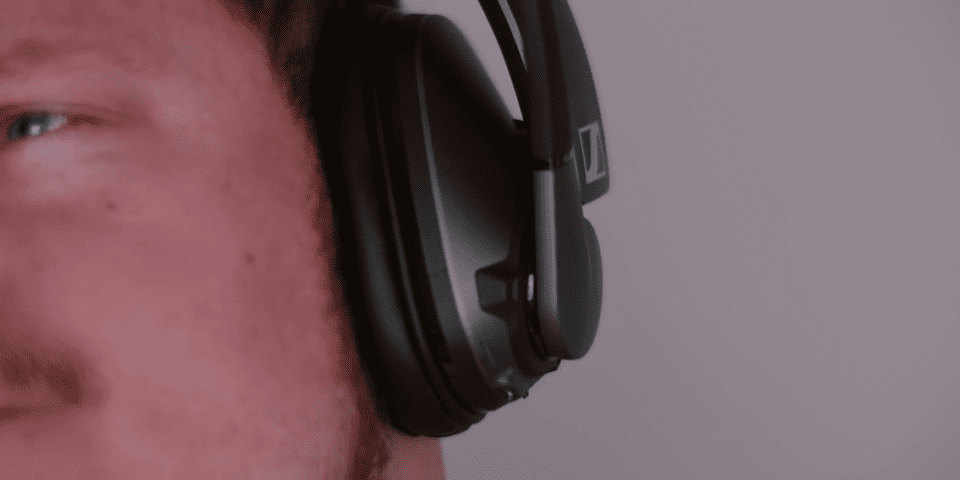What HAPPENED! Sennheiser GSP 370 Gaming Headset Review

Share:
The Sennheiser GSP 670 has disappointed me in the past and I’m told the new GSP 370 is supposed to make up for it, so let’s see if it does.
This headset has so much potential. I mean it’s Sennheiser we are talking about, they sound great, they make fantastic hardware that lasts forever, but software is not their strong suit. As you guys should know by now, I keep all relevant headsets in my collection, so when new products come out I can do a proper comparison. So I’m going to check out this pair, then do mic test, and conclude with my current wireless headset recommendation.
Differences & Features
Right off the bat, these are a lot more comfortable than the bulky GSP 670. The GSP 370 has a smaller frame and less clamping force, and they still look a bit ridiculous, but nowhere near the ugly fit of the GSP 600 series. We have a nice and tight seal for great passive isolation, and the ear cups are fantastic with this velvet top layer that makes contact with your skin and the leather body for the exterior that beautifully traps those bass hits.
No issues wearing these with glasses too, and this is easily the most comfortable wireless headset in my collection. Color wise I appreciate the dark tones, it’s a good looking pair. These are not Bluetooth unlike the GSP 670, the wireless connection is handled by the USB dongle that is labeled on their side for clarification. You can always stash the USB inside the ear cup for storage.
Everything is plastic the way it should be to keep the way down, which provides insane flexibility of the frame and robust size extensions. As usual, the massive boom mic is not removable, but is muted when in the upright position. The volume wheel on the right now has the soft tactile steps that move in 2% increments, and the actual volume adjustment is not immediate it catches up in a few seconds. You charge this pair with the Micro-USB port at the bottom, kind of sucks that they still have not moved to USB Type-C yet. The power button is the dinkiest slider that I’ve seen, it doesn’t even deserve to be in such a premium body.
The Upsides
The reason why I initially considered this to be my new favorite wireless headset is because of comfort, battery life, and sound quality. Comfort wise they’re fantastic, but battery life has impressed me the most. They are rated for a 100 hours and I used them for a week extensively – easily over 70 hours of usage – and only then did they drop to the 20% low battery beep. So as advertised these will last you for a long time. And as for sound, they are pretty powerful. I run these at between 60% and 80% volume, so there’s a bit of headroom left in terms of power output. They are tuned to sound a bit more open, so the soundstage is not super claustrophobic and closed off like you would find on the Corsair Virtuoso. The detail resolution is nowhere near what I would get with a wired pair, like my Sennheiser HD 58X Jubilee.
The sound clarity is very pleasant to my ears. It’s smoother than the HyperX Cloud Flight, the Logitech G935, and the Corsair Virtuoso combined. The treble is smooth, nice roll-off in typical Sennheiser fashion, with nice bass trapping in there as well that doesn’t overpower frequencies. The main thing is you can tell this a wireless headset because the clarity and the resolution of the detail that you would normally find on the wired pair is not exactly on the level, but it’s pretty satisfactory. I will say the layering is so much better with GSP 370 versus the Corsair Virtuoso and the Cloud Flight, but they do sound pretty comparable to the G935 from Logitech. I really liked that sound signature. This was a very good pair for a CS:GO and Quake. I could hear all of my regular audio cues for awareness, so everything in that sense was well-delivered. Environmental ambiance in Red Dead 2 and Fallen Order were also perfectly fine, no complaints with the driver performance.
The Downsides
And this is where we stopped the hype train and talk about all the issues, which is basically the microphone and the software. The microphone sounds really poor for the price point. For $199 USD you would expect much more coming from Sennheiser. Furthermore, the side tone feature is disabled, while it was fully enabled and working properly on the GSP 670, and the noise cancellation slider is also greyed out so you can not even adjust than the noise cancellation properties. So much for the noise canceling broadcast quality microphone. This is unacceptable for my ears. By comparison, the Corsair Virtuoso wireless headset sounds slightly better, not as compressed and not as nasally. There is a bit more clarity in there. It doesn’t have as much bass as the Sennheiser, but I think this is a better sounding microphone. The HyperX Cloud Flight has embarrassing microphone quality, and yet still not as bad as the GSP 370, but this thing is half price. If I take a proper quality microphone, like the wired Sennheiser PC 37X, and run it through the SoundBlaster X3 that has a mic input, the microphone quality can actually be fantastic. This is what you are up against in terms of sound quality on the wireless side versus a proper wired headset.
And now here’s an embarrassing fact, as I plugged in the GSP 670 into my machine to record a mic sound test and compare it to the GSP 370, my machine crashed and the headset was not being recognized by the dongle. I have not used that headset since the review, so that’s very odd, but the Sennheiser gaming suite software really needs to be fixed and improved. Unfortunately, I’ve also experienced many other issues with the GSP 370 on my main editing AMD Thread Ripper system, like crackles coming through the headset when the dongle is plugged into the front USB port on the case. When I plug in the dongle into the motherboard, the crackles become less frequent but hey are still present. The headset will also not wake up after I reboot the system, and I have to replug the dongle every single time, which does not happen on any of my Intel machines. I will also say that the microphone did stop working while I was in game, twice! Everything else was working perfectly fine, I could hear my audio, but my microphone just stopped picking up my audio until I replugged the USB dongle. Furthermore, at one point audio got fully distorted, which is actually something that I’ve experienced with the GSP 670 really early on, before the firmware updates. It’s kind of strange to hear that and once again it was all resolved when I replugged the USB dongle.
Conclusion
And so the entire experience with the GSP 370 has its plusses and minuses. The software and all of its issues killed the competitive nature of this headset despite it being super comfortable and sounding very good for a wireless pair. But to be honest, no headset should cause as much frustration as I’ve experienced both on the GSP 670 and the GSP 370 now. I’m sure Sennheiser are working on upgrading the Sennnheiser driver suite software, but it was also a big weak point for the previous wireless headset.
Right now my wireless recommendation still stands with the HyperX Cloud Flight, even though the microphone sounds like trash, and they don’t sound as good as the GSP 370 or the GSP 670. They are extremely comfortable, I’ve never encountered any sort of issues in terms of drivers and the microphone not working, the audio distorting, it shutting down my system, it not working with DaVinci Resolve, etc. The issues that arise with something like that are just unexpected from the Sennheiser side, which is why the Cloud Flight still is my wireless recommendation.







































